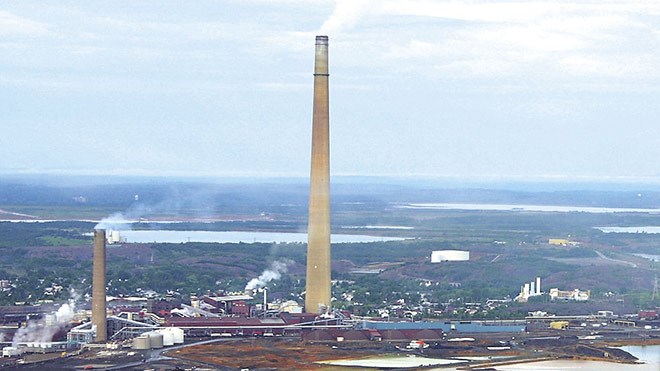At its peak, the concentration of nitrogen dioxide that escaped from Vale's acid plant in Copper Cliff on Thursday reached the limit of what the Ministry of the Environment considers safe for short-term exposure, NorthernLife.ca has learned.
In a press conference Thursday afternoon, Jody Kuzenko, Vale's general manager of production services in Sudbury, said nitrogen dioxide levels in the air peaked at 0.5 parts per million at the perimeter of its Copper Cliff property.
The Ministry of the Environment's acute exposure limit for nitrogen dioxide is also 0.5 parts per million, and its limit for long-term exposure is 0.2 parts per million. The substance is a brown-orange gas that can cause irritation to the eyes, nose, mouth and lungs at low levels, and serious health complications at high concentrations.
Kuzenko said Thursday the concentration levels of the gas were “well below the limits that create a risk for personal safety."
However, the limit Kuzenko was referring to is the Ministry of Labour's exposure limits under the Occupational Health and Safety Act – limits that are significantly less strict than the Ministry of the Environment's.
Ministry of Environment spokesperson Kate Jordan said Friday their measurements are meant to inform the population about the ambient air quality, while the Ministry of Labour's measurements would be intended for workers, typically working indoors.
Concentration levels the Ministry of the Environment measured in downtown Sudbury peaked at 0.02 parts per million — much lower than those Vale measured in Copper Cliff.
“(So) I don't think it turned out to be a downtown danger,” said David Pearson, an earth sciences professor at Laurentian University.
But, Pearson said, he was surprised at the nitrogen dioxide concentration Vale reported in Copper Cliff.
“That seems to be to be higher than I would have expected it to be,” he said.
When reached for comment, Vale's manager of corporate and Aboriginal affairs acknowledged the nitrogen dioxide reading hit the Ministry of the Environment's peak limit, but clarified the high reading represented a spike, not a continuous, long-term reading.*
"Under the Occupational Health and Safety Act, the (long-term) exposure limit for NO2 (nitrogen dioxide) is three parts per million (eight-hour average) and the short-term exposure limit (15-minute average) is five parts per million," Angie Robson said.
"We are currently investigating this incident further, but as far as we know it today, the highest instantaneous reading we saw at the perimeter of our property was 0.5. The ministry limits referred to are over a longer period of time (as we understand it, long term is 24 hours and short term is one hour)."
During the press conference Thursday, Kuzenko said the gas formed when Vale employees washed sulphuric acid reservoirs with water, part of a planned maintenance period. She said the procedure often creates a reaction between the water and acid that creates a small amount of nitrogen dioxide. But, she added, the reaction Thursday created much more of the gas than normal.
Pearson said nitrogen dioxide is created when air is exposed to very high temperatures – typically through combustion. Car engines, cigarettes and even campfires create small amounts of the gas by combining nitrogen and oxygen molecules.
The investigation into the Aug. 13 gas leak continues.
*An earlier version of this story omitted the statement from Vale spokesperson Angie Robson. NorthernLife.ca apologizes for the omission.
